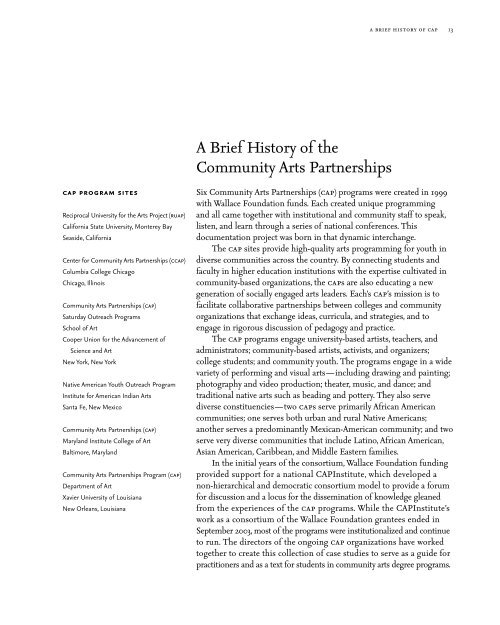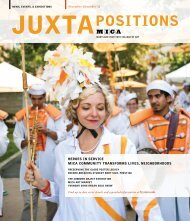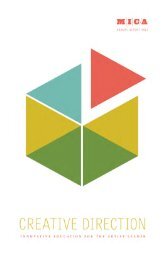art/vision/voice - Maryland Institute College of Art
art/vision/voice - Maryland Institute College of Art
art/vision/voice - Maryland Institute College of Art
Create successful ePaper yourself
Turn your PDF publications into a flip-book with our unique Google optimized e-Paper software.
cap program sites<br />
Reciprocal University for the <strong>Art</strong>s Project (ruap)<br />
California State University, Monterey Bay<br />
Seaside, California<br />
Center for Community <strong>Art</strong>s P<strong>art</strong>nerships (ccap)<br />
Columbia <strong>College</strong> Chicago<br />
Chicago, Illinois<br />
Community <strong>Art</strong>s P<strong>art</strong>nerships (cap)<br />
Saturday Outreach Programs<br />
School <strong>of</strong> <strong>Art</strong><br />
Cooper Union for the Advancement <strong>of</strong><br />
Science and <strong>Art</strong><br />
New York, New York<br />
Native American Youth Outreach Program<br />
<strong>Institute</strong> for American Indian <strong>Art</strong>s<br />
Santa Fe, New Mexico<br />
Community <strong>Art</strong>s P<strong>art</strong>nerships (cap)<br />
<strong>Maryland</strong> <strong>Institute</strong> <strong>College</strong> <strong>of</strong> <strong>Art</strong><br />
Baltimore, <strong>Maryland</strong><br />
Community <strong>Art</strong>s P<strong>art</strong>nerships Program (cap)<br />
Dep<strong>art</strong>ment <strong>of</strong> <strong>Art</strong><br />
Xavier University <strong>of</strong> Louisiana<br />
New Orleans, Louisiana<br />
A Brief History <strong>of</strong> the<br />
Community <strong>Art</strong>s P<strong>art</strong>nerships<br />
a brief history <strong>of</strong> cap 13<br />
Six Community <strong>Art</strong>s P<strong>art</strong>nerships (cap) programs were created in 1999<br />
with Wallace Foundation funds. Each created unique programming<br />
and all came together with institutional and community staff to speak,<br />
listen, and learn through a series <strong>of</strong> national conferences. This<br />
documentation project was born in that dynamic interchange.<br />
The cap sites provide high-quality <strong>art</strong>s programming for youth in<br />
diverse communities across the country. By connecting students and<br />
faculty in higher education institutions with the expertise cultivated in<br />
community-based organizations, the caps are also educating a new<br />
generation <strong>of</strong> socially engaged <strong>art</strong>s leaders. Each’s cap’s mission is to<br />
facilitate collaborative p<strong>art</strong>nerships between colleges and community<br />
organizations that exchange ideas, curricula, and strategies, and to<br />
engage in rigorous discussion <strong>of</strong> pedagogy and practice.<br />
The cap programs engage university-based <strong>art</strong>ists, teachers, and<br />
administrators; community-based <strong>art</strong>ists, activists, and organizers;<br />
college students; and community youth. The programs engage in a wide<br />
variety <strong>of</strong> performing and visual <strong>art</strong>s—including drawing and painting;<br />
photography and video production; theater, music, and dance; and<br />
traditional native <strong>art</strong>s such as beading and pottery. They also serve<br />
diverse constituencies—two caps serve primarily African American<br />
communities; one serves both urban and rural Native Americans;<br />
another serves a predominantly Mexican-American community; and two<br />
serve very diverse communities that include Latino, African American,<br />
Asian American, Caribbean, and Middle Eastern families.<br />
In the initial years <strong>of</strong> the consortium, Wallace Foundation funding<br />
provided support for a national CAP<strong>Institute</strong>, which developed a<br />
non-hierarchical and democratic consortium model to provide a forum<br />
for discussion and a locus for the dissemination <strong>of</strong> knowledge gleaned<br />
from the experiences <strong>of</strong> the cap programs. While the CAP<strong>Institute</strong>’s<br />
work as a consortium <strong>of</strong> the Wallace Foundation grantees ended in<br />
September 2003, most <strong>of</strong> the programs were institutionalized and continue<br />
to run. The directors <strong>of</strong> the ongoing cap organizations have worked<br />
together to create this collection <strong>of</strong> case studies to serve as a guide for<br />
practitioners and as a text for students in community <strong>art</strong>s degree programs.
















